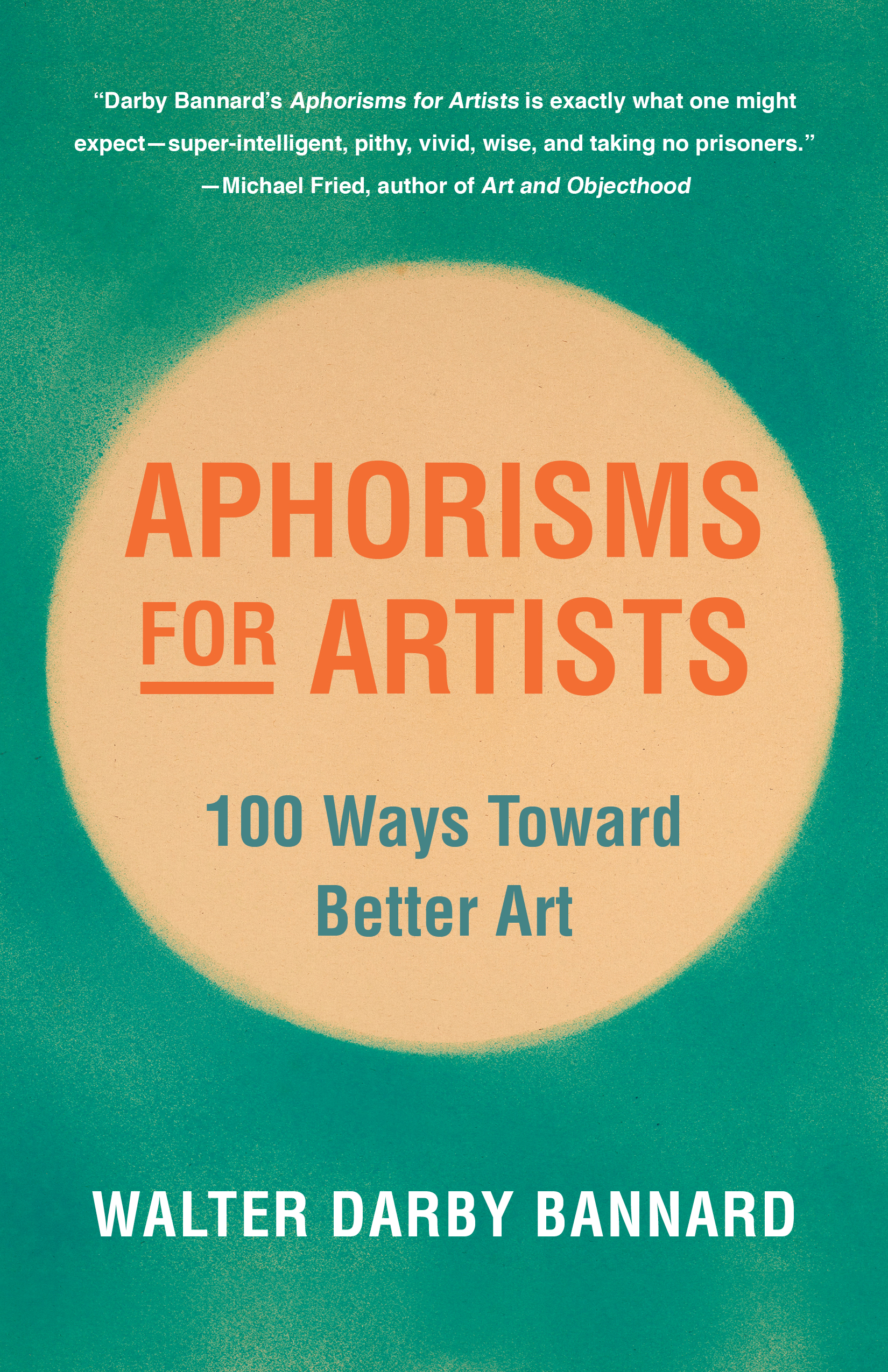

Why do young artists struggle to find their voices? Walter Darby Bannard, having come to the University of Miami after achieving renown as a critic for Artforum and an internationally exhibited painter, contemplated that question for more than two decades.
Prior to his passing in 2016, at the urging of one of his former students, Bannard set down his thoughts in a short book, Aphorisms for Artists: 100 Ways Toward Better Art. It is at once a volume of practical art-making wisdom and an engaging piece of personal philosophy, both wry and readable.
Open to any page, and you'll find a memorable gem of wisdom, followed by a brief expansion by Bannard that adds even more insight.
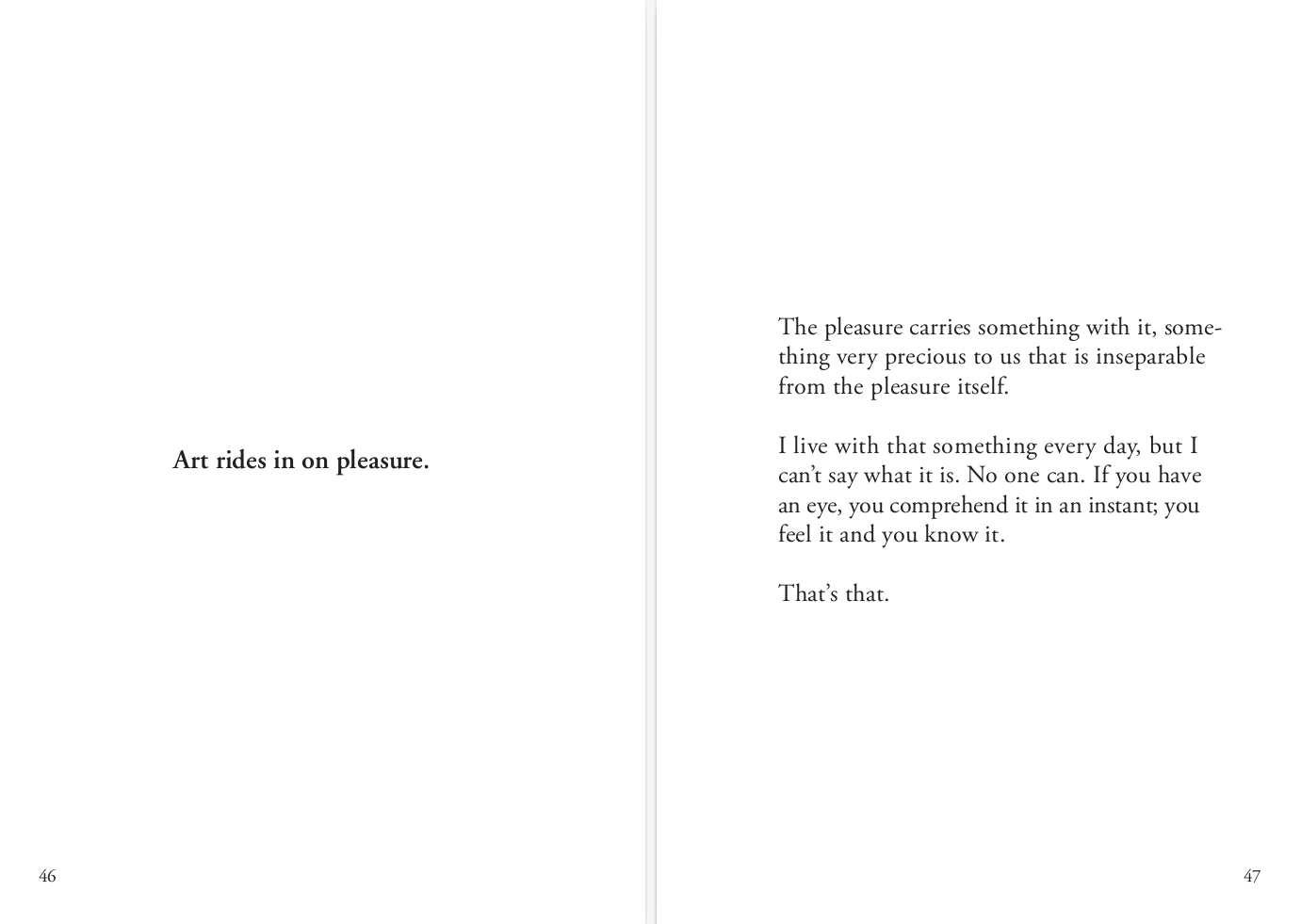
(click for full image)
Read and re-read it cover to cover, or consult it like an oracle in times of artistic trouble. It is a necessary reference to keep handy in the studio, and a perfect gift for the aspiring artist.
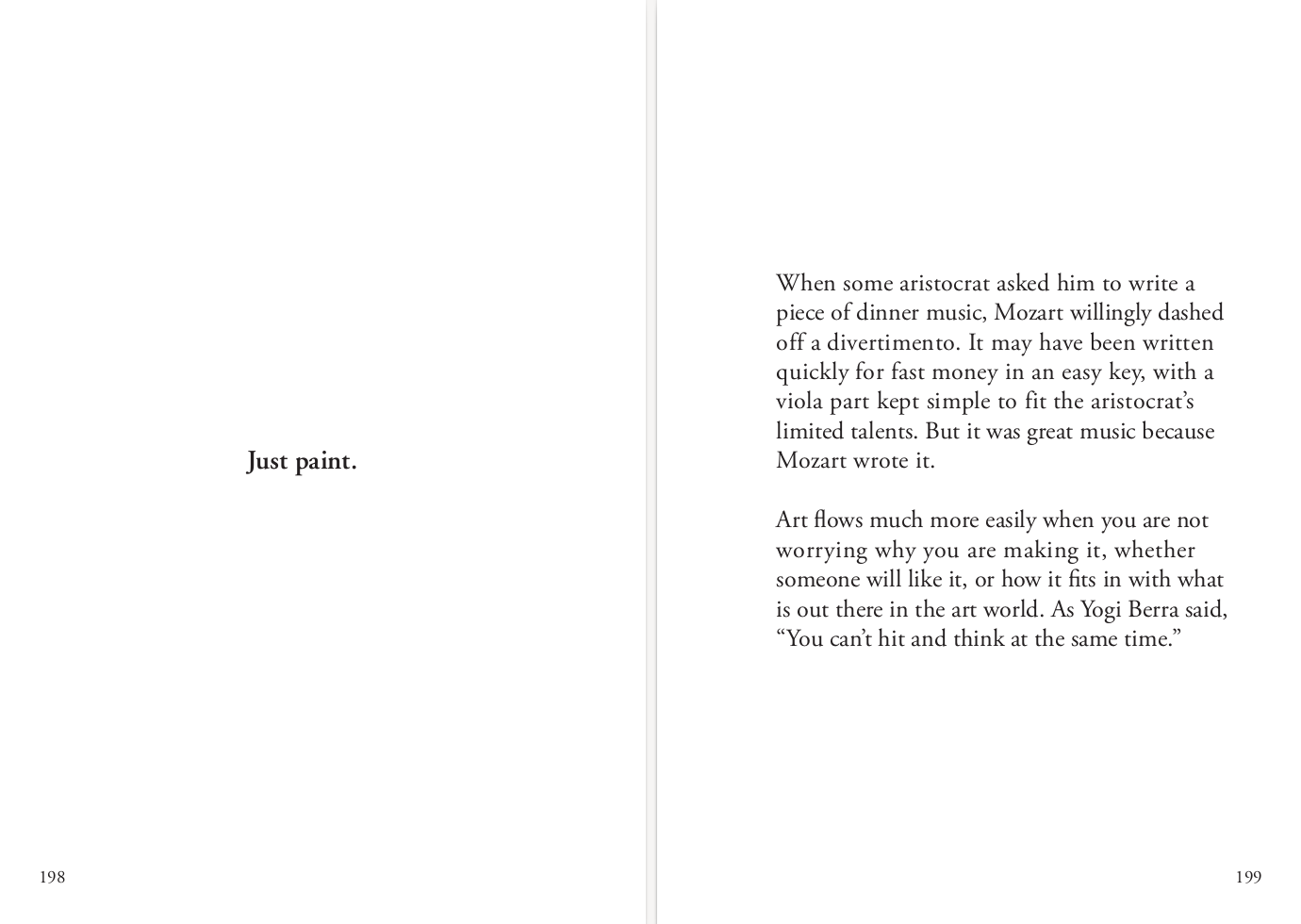
(click for full image)
Book information: Trim size 5.5 x 8.5 inches, 240 pages, retail price $16.99. ISBN 9781621538394. Edited by Franklin Einspruch, forewords by Einspruch and Bannard, afterword by Einspruch. Published by Allworth Press, January 23, 2024.
Buy your copy of Aphorisms for Artists

Walter Darby Bannard in his studio. Photo: Jim Arbogast
Walter Darby Bannard is considered to be one of the most important painters of second-generation American abstract expressionism, along with Frank Stella, Larry Poons, Kenneth Noland, and Jules Olitski. From the foreword to Aphorisms for Artists by Franklin Einspruch:
Walter Darby Bannard (1934-2016), “Darby” to those who knew him, played a crucial role in the history of postwar American art. His paintings have been the subject of hundreds of shows, including “The Responsive Eye,” the seminal exhibition of abstraction at the Museum of Modern Art in 1965. They reside in museum collections from the Whitney Museum of American Art in New York to the Centre Georges Pompidou in Paris to the National Gallery in Victoria, Australia. His own writing on art was no less widely seen, published in journals such as Art in America and Artforum, as well as in the New York Times. Along with the influential critic Clement Greenberg, who became a lifelong champion of his after they met in the late 1950s, Darby was one of the great intellects of modern art, whether he was analyzing it or creating it himself.
Bannard was brought onto the faculty of the Department of Art at the University of Miami in 1989. He chaired the department for many years, and he taught there until he passed away. Via his teaching he influenced thousands of students creatively and intellectually, in Miami and beyond.
Barbara Rose remembered him in Artforum:
Walter Darby Bannard was born to win. He was the perfect American, a taller, more physically imposing but equally charming version of Warren Beatty, smiling and savvy, brilliant but mischievous. He could have been a movie star, a tennis pro, or at the very least a successful banker sporting a navy blazer and Exeter and Princeton degrees. But he wanted none of what the world could offer him.... Bannard was the hipster’s square. He enjoyed the appearance of conformity and pursued a life that looked conventional. But, in truth, he was neither conventional nor a conformist, in either his life or his art.
The estate of Walter Darby Bannard is represented by Berry Campbell Gallery in New York City.
Buy your copy of Aphorisms for Artists
“Born, artistically speaking, into a world that prized flatness, Darby turned that world into a world of surface, surprisingly independent of the picture plane. He made his surfaces into expressions of beauty, and what Malevich called ‘pure feeling.’”—Frank Stella, artist
“Darby was a faithful artist and a faithful friend, and lovingly used to call me a coot.”—Larry Poons, artist
“Darby Bannard was a fiercely intelligent, deeply knowledgeable, inventive abstract painter. He was also an influential teacher, and a splendid critic and writer about art, with a wicked wit, capable of summing up and often skewering whole movements with a pointed phrase. While he was intolerant of one-liner art, his condensed critical observations are illuminating and memorable. Reading his aphorisms brings this smart, articulate, gifted artist back to vivid life.”—Karen Wilkin, critic and curator
“Darby Bannard’s Aphorisms for Artists is exactly what one might expect—super-intelligent, pithy, vivid, wise, and taking no prisoners. Anyone lucky enough to have known Darby will recognize his inimitable voice.”—Michael Fried, author of Art and Objecthood
“From the outrageous, to the benign, to the wonderfully insightful, Walter Darby Bannard's aphorisms are provocations for 100 never-ending—and absolutely essential—arguments about art. Quote one of ‘em at an artists’ bar, and you’re there for the night—buying a few rounds when you lose.”—Peter Plagens, artist and critic

Walter Darby Bannard. Photo: Jim Arbogast
“Darby minced no words, suffered no fools, and had a huge following. With extraordinary intelligence and wit his Aphorisms for Artists is an important legacy of this masterful artist and teacher.”—Loretta Howard, Loretta Howard Gallery
“Ken Noland introduced me to Darby. I thought he was a terrific painter and should be in the Deluxe show. He used paint differently than anybody else I knew.”—Peter Bradley, artist
“Besides being a damn good painter, Walter Darby Bannard was a provocative art critic. Beginning with an essay on ‘Color, Paint, and Present-Day Painting’ that appeared in the April 1966 issue of Artforum and then, later on, in an array of publications, including Arts magazine and a wide-ranging group of exhibition catalogues, Bannard shared his thoughts regarding the role of the artist and what his predecessors and contemporaries had achieved. His articles and statements are an important record of their time period.”—Phyllis Tuchman, critic
“Darby Barnard moved from producing proto-minimalist works in the 1960s to process driven paintings in the 2000s. What drove this trajectory was a desire to make paintings that just were. Likewise, he sought to be succinct in all that he did, be it his teaching, paintings, or criticism. He found himself in a constant struggle between what could be said and what was factual. As one of Darby Bannard’s more unforgettable teaching devices, his Aphorisms has come to be handed down from one generation of students to the next. Though intended as truisms, each opens the way for reflection and debate.”—Saul Ostrow, critic
Buy your copy of Aphorisms for Artists
“In the writings of Walter Darby Bannard I found a more concise understanding of the major focus of Clement Greenberg’s work: Visual art is about looking, as food is to tasting and smelling. Art can certainly share stories, just as we have stories of the meaningfulness of certain meals. Yet in the end, it is taste that matters. That taste develops the more we experience. Aphorisms for Artists compiles Bannard’s short, cogent messages for artists and art enthusiasts of all ilk, to help us grasp something that is often too ephemeral for words. I find myself coming back to them time and time again, especially ‘Art is as persistent as it is fragile.’ I am confident that Aphorisms for Artists will inspire, and with each read we will understand more about the value of art, ‘telling us what’s good about us.’”—Mark Golden, Golden Artist Colors
“The son of a preacher, Walter Darby Bannard made authoritative statements informed by years of painting and reflection. His work has yet to be properly celebrated for its versatility of spirit. In the meantime we have his Aphorisms for Artists, rich food for thought.”—Elisabeth Condon, artist
“Aphorisms for Artists is a wise and witty collection of insights into art by a gifted artist and art critic. It should be of interest to creative spirits at every stage in their careers.”—Piri Halasz, ciritic

Walter Darby Bannard. Walter Darby Bannard, Orange Blacksides, 1959, alkyd resin on canvas, 66 3/4 x 60 1/2 inches, courtesy of Berry Campbell Gallery
“As an artist who teaches abstract painting, I know how difficult it is to articulate how an art student or artist might become a better one. Bannard’s Aphorisms for Artists speak to this problem with pithy comments on an artist’s approach when thinking and working. They contain a large dose of useful wisdom on art-making for the working artist. They also address the ongoing mystery of how or why some abstract art is so compelling while much is so lacking, and how to understand the gulf between.”—Jill Nathanson, artist
“Walter Darby Bannard was the Ben Franklin of the art world, producing aphorisms and epigrams so witty and astute they deserve to be passed on from one generation to another. Read through these and you may soon find yourself sending them to friends or tacking his insights on to your studio wall.”—Ann Landi, director, The Wright Contemporary
“I met Darby in the early 1990s as I began showing art in the small upstairs apartment that would later become Emerson Dorsch Gallery. Working with him helped me understand the clarity of his vision as well as his approach to making art and being an artist. Many of Darby's aphorisms have stuck with me over the years. ‘Fun is profound.’ ‘Just paint.’ Sometimes when the art world unfurls something ‘new,’ I return to my eye and the Aphorisms and take a closer look. Thank you Darby.”—Brook Dorsch, Emerson Dorsch Gallery
“Walter Darby Bannard's candid, modernist axioms update and expand on Robert Henri’s timeless collected wisdom in The Art Spirit. These newly gathered affirmations also examine themes of inspiration and the nature of the creative process, but from a mid-20th century point of view, significantly taking a critical look at the extant art world. At once an analytical and instructional read, Aphorisms for Artists forges new appreciation for the advice of this recognized abstractionist and outspoken educator.”—Kim Uchiyama, artist
“Aphorisms for Artists, a compilation of the compelling maxims by the renowned painter Walter Darby Bannard, brought me back to the freshness of beginning my own studio practice. If you are an aspiring or established artist, you will appreciate his pithy and extraordinary insights, which teach us at all levels how to continue to develop our own voices.”—Jeannie Motherwell, artist
“Walter Darby Bannard was a fluid, jargon-free art writer. His Aphorisms for Artists encapsulates the deep view and direct reactions he had to art and its making. Seemingly a collegiate among the hipsters, Darby was one of the hippest when it came to explicating the mechanics of a painting. Aphorisms, or any of his essays, are reliable tune-ups for artists of any stripe.”—James Walsh, artist
Buy your copy of Aphorisms for Artists
“Bless the writer’s half of Darby Bannard’s brain! As succinctly as anyone ever has, Bannard has given us a record of what it is to be an abstract painter. In artist’s “studio talk” terms, he explains how making art is about focusing in on aesthetic experience and aesthetic decisions. He gets as close as anyone has, in writing, to a reasoned explanation of quality and an understanding of the mind’s cognitive experience of art. For painting’s sake and for our sake, a lot of it got written down in Aphorisms for Artists.”—Ann Walsh, artist
“Darby's writings are most inspirational to me. He was an elegant, smart dude, but down-to-earth in his thinking about art. The use of color in his early flat paintings reflect his succinct philosophy, and I admire the physicality of paint in his later works. ‘See first. Name later,’ says one aphorism; I share the belief that defining a piece is secondary to the creation of the work. Another that rings true is ‘New art is not always good art, but good art is always new art’— just because it's new, doesn't mean it's good! But when art is good, it sweeps away doubt.”—Francine Tint, artist
“Walter Darby Bannard’s aphorisms are as elucidating as Picasso’s interviews or Cezanne’s letters. This concise collection offers insight into the principles of a storied generation of painters and a glimpse of what it was like to work in dialogue with a modern master.”—Andy Gambrell, artist
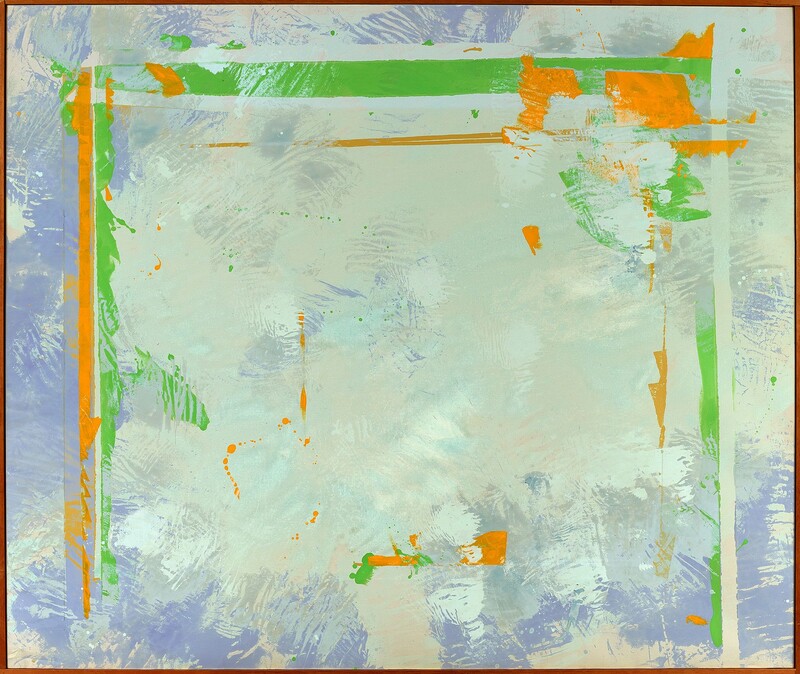
Walter Darby Bannard, The Plains #2, 1970, alkylin resin on canvas, 78 x 93 inches, courtesy of Berry Campbell Gallery
Walter Darby Bannard cut to the chase. He wrote clearly and conversationally about art, about the “art world,” about the dishonesty of postmodernism, and about the rationalization of lower standards to sell more art, and he did it with honesty, seriousness, and a sense of humor.”—Scott Bennett, artist
“Darby’s keen eye and clear mind were unmatched in the studio. His interest was making the best art possible. No exceptions. He tirelessly looked, cropped and rotated his pictures until surface, color, and design were at there best. He was enormously generous to younger artists who sought his advice on advancing their own work regardless their style or genre.”—George Bethea, artist
“I worked alongside Darby for nearly thirty years as his colleague in the University of Miami graduate painting program. What I witnessed during his interactions with students throughout those years was nothing less than a master class in aesthetic sensitivity, wide ranging intelligence, insatiable curiosity, emotional generosity, and an ever-present and highly perceptive sense of humor. Aphorisms for Artists is a collection of straightforward and unflinchingly concise personal insights derived from a life of making art and teaching aspiring artists. In these one-hundred easily digestible, implicit, evocative one-liners, Darby skillfully boiled down simple intuitive truths into a multidimensional astrological star map capable of providing us with aesthetic orientation during our continuing search for deeper wisdom.”—Brian Curtis, artist, author of Drawing from Observation: An Introduction to Perceptual Drawing
“In our time, when so many in the art world have been trained to see art as propaganda, it’s good to read the wise painter Darby Bannard write, ‘Relevance has nothing to do with it.’ For those of you who don’t get the autonomy of art, this book will help. For artists, this work carries on in the spirit of the great Ad Reinhardt (‘Art is art and life is life’) and will help you understand the integrity of art.”—Dana Gordon, artist
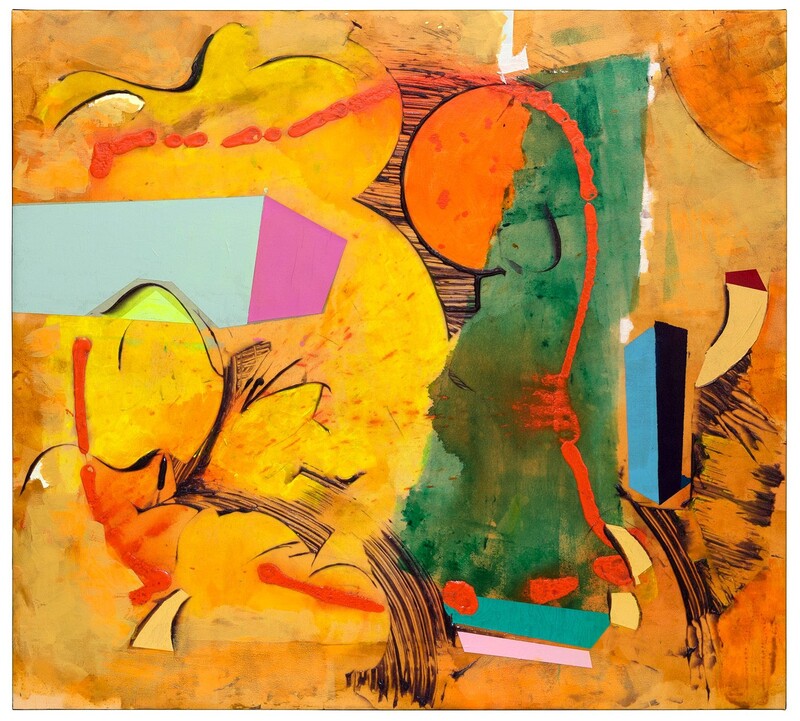
Walter Darby Bannard, Prodigal Sun (15-23A), 2015, acrylic on canvas, 49 1/2 x 55 inches, courtesy of Berry Campbell Gallery
“What I most appreciate and miss about Walter Darby Bannard as a mentor, colleague, and friend was that his wisdom did not require volumes of art-speak to explain. While certainly an eloquent writer, he preferred to stand in the center of the ring, using a single left hook to send his message. His efficiency did not require the showmanship of fancy footwork, ducking, or weaving. Central to his message to me as a young artist was always to keep my practice enjoyable, to never lose sight of the tactile enjoyment that art-making provided—something we all clearly understand as children but seem to forget as we grow older.”—Kyle Trowbridge, artist, Antillectual Recordings
“Not unlike a master mechanic, Darby Bannard offered succinct, pragmatic observations in his advice regarding the process of creation. He was able to put his finger on things that needed adjustment, mostly as a result of countless hours making, looking, revising, and remaking. His prodigious work ethic fueled his commentary.”—Tom Virgin, artist, Extra Virgin Press
When I first began painting, I would sit in the back of Darby’s Friday painting critiques as I was afraid to talk because I had no idea what to say. One day I realized Darby was saying things that I was thinking. I mustered the courage to speak up more and eventually I heard Darby say, “I agree with Jackie’s opinion.” I was over the moon to know that I could see something of what he saw. And boy the things he must have seen—sixty years of looking at all types of paintings, devouring them, sharing images of them with his students. Darby gave me the confidence to become and remain a painter.”—Jacqueline Gopie, artist
The first edition of Aphorisms for Artists was published by Letter16 as a Signature16 project. First edition book details: 4w x 5.75h inches, 224 pages, retail price $24.95. Cover is canvas-textured paper mounted on 250-gram board, with two-color foil stamp. Endpapers are 140-gram wood-free paper, printed blue. Text stock is 100-gram wood-free paper. Flexible binding with orange ribbon bookmark. ISBN 978-1-953995-02-5. Copies of the first edition are now collector's items, but limited numbers are available from Letter16 and Dissident Muse.
For more information, including press inquiries, contact Franklin Einspruch at dissidentmuse@proton.me.